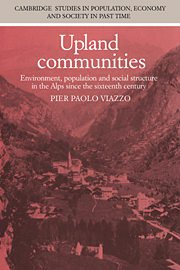 Upland Communities
Upland Communities Book contents
- Frontmatter
- Contents
- List of illustrations
- List of tables
- List of abbreviations
- Acknowledgements
- Introduction: anthropology, historical demography and the study of mountain societies
- 1 Environment, population and social structure: the Alpine village as an ecosystem
- 2 Open systems, open questions
- 3 Anthropologists in the Alps
- 4 The changing demography of Alpine communities
- 5 The traditional economy and its demise
- 6 The causes and consequences of Alpine emigration
- 7 The wealth from the earth: mining and immigration
- 8 Population, resources and homeostatic regulation
- 9 The domestic domain
- 10 Upland communities
- A summary of conclusions
- Bibliography
- Index
2 - Open systems, open questions
Published online by Cambridge University Press: 13 October 2009
- Frontmatter
- Contents
- List of illustrations
- List of tables
- List of abbreviations
- Acknowledgements
- Introduction: anthropology, historical demography and the study of mountain societies
- 1 Environment, population and social structure: the Alpine village as an ecosystem
- 2 Open systems, open questions
- 3 Anthropologists in the Alps
- 4 The changing demography of Alpine communities
- 5 The traditional economy and its demise
- 6 The causes and consequences of Alpine emigration
- 7 The wealth from the earth: mining and immigration
- 8 Population, resources and homeostatic regulation
- 9 The domestic domain
- 10 Upland communities
- A summary of conclusions
- Bibliography
- Index
Summary
Closed systems, homeostasis and history
A major feature of the ecological model of the upland community presented in Chapter 1 is that the sequence of arguments which has been outlined parallels the main stages in the development of ecological anthropology, from Steward's ‘cultural ecology’ to Rappaport's ‘neo-functionalism’ and the more recent ‘processual’ approach. This does not mean of course, that the development of ecological anthropology has consisted in a smooth accumulation of information and insights. As Benjamin Orlove has rightly stressed, ‘each stage is a reaction to the previous one rather than merely an addition to it’. Nevertheless, each stage has been less a radical break from the previously dominant approach than an intellectual outgrowth of it. This explains why, instead of repudiating Steward's legacy, a number of anthropologists adopting an ecosystemic approach have tried to build upon the achievements of cultural ecology. In the field of Alpine studies, this is most clearly demonstrated by Netting's work, which mainly focusses on regulation but incorporates the Stewardian concerns with irrigation systems and intensification strategies. It also shares with the explicitly cultural-ecological models proposed by Burns and by later writers a set of assumptions and claims about the adaptivity of communal forms of social organization and the crucial structural importance of closed corporate communities in mountain areas. Admittedly, comparative work of the kind in which anthropologists like Rhoades and Thompson or Guillet have engaged inevitably presents considerable methodological problems.
- Type
- Chapter
- Information
- Upland CommunitiesEnvironment, Population and Social Structure in the Alps since the Sixteenth Century, pp. 31 - 48Publisher: Cambridge University PressPrint publication year: 1989
